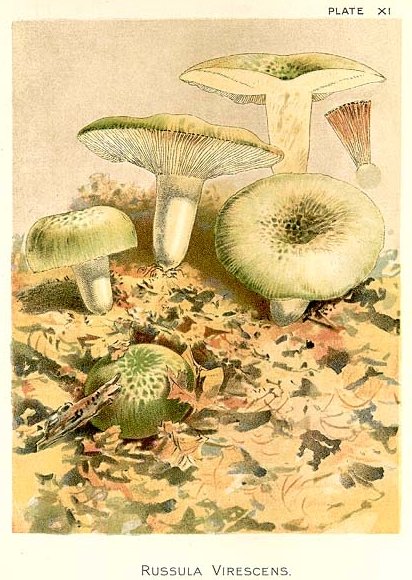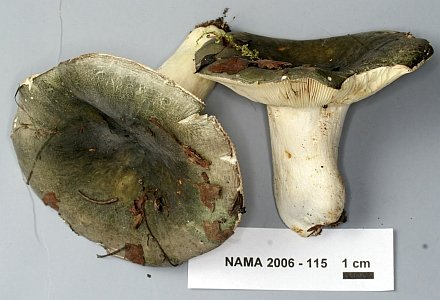The green cracking Russula (Russula virescens (Schaeff. ex Zanted) Fr.) on display at NAMA 2006.
Classification
Kingdom Fungi
Phylum Basidiomycota
Class Basidiomycetes
Order Russulales
Family Russulaceae
Genus Russula
Synonyms
Agaricus virescens Schaeff.
Fung. Bavar. Palat. 4: 40 (1774)
Common Names
Quilted green russula
Green cracking russula
Greencracked brittlegill
Holubinka nazelenalá (Czech)
Spanskgrøn skørhat (Danish)
Ruwe russula (Dutch)
Ruutuhapero (Finnish)
Grünschuppiger/Grünfelderiger/Grüngefeldeter/Gefeldeter/Felderiger Täubling (German)
Russule verdoyante (French)
Bise verte (French)
Varashátú galambgomba (Hungarian)
Gołąbek zielonawy (Polish)
Rutkremla (Swedish)
Сыроежка зеленоватая (Russian)

My name is Austin Collins.
I've dedicated my life to Mushrooms.
I believe Mushrooms are the best kept secret when it comes to health and well being.
For that reason, I would like to share a company with you that in my opinion makes the best mushroom products on the market.
The company is called Noomadic Herbals, my favorite supplement they make is called "Mushroom Total".
I take their products every day and they have helped me think better and have more energy. Give them a try.
-Austin
Description
Cap: 5-15 cm in diameter, initially subglobose, later convex; flat and often depressed in the center when mature; thick, fleshy and very firm; verdigris-green or pale-olive-yellow with rusty-brown spots; it is usually dry with small flocculose patches or warts; when mature it splits at the margin and the cuticle cracks and shrinks; cuticle not easily peeled.

Gills: free to adnate, crowded, 5-10 mm wide and not attached to the stem; initially white, later cream; brown at the edge when mature.
Stem: 6-12 cm long, 1.5-4 cm thick; cylindrical, firm and solid when young but spongy, brittle and white when mature, turning yellow when bruised.
Flesh: very firm and crunchy when young, becoming soft and brittle in age; white, often turning rusty-yellow when cut.
Spore print: white, sometimes pale cream.
Spores: subglobose, with short spines (echinulate) and fine dots forming an incomplete network, colorless, 8-9 x 7-8 µm.
Taste and odor: mild.
Edibility: listed as edible; however, be aware that hydrazine derivatives have been detected in this species (Chiarlo et al., 1984).
Habitat: on the ground in small groups, often under beeches and birches in deciduous or mixed woods; more common in dry weather when other mushrooms do not thrive; June to October.
R. parvovirescens is a similar but smaller species that has been mistaken for R. virescens or R. crustosa. It may be readily distinguished from the latter two species by microscopic characteristics (Buyck et al., 2006).

Medicinal properties
Blood lipid regulation/hypocholesterolemic effects
A Chinese study suggests that R. virescens has beneficial effects on blood lipid regulation. Rats given high (600 mg/kg/day) and low (300 mg/kg/day) doses of R. virescens via stomach perfusion for 30 days had significantly (P<0.05) lower levels of total cholesterol, total low-density lipoprotein cholesterol, and triglycerides than in the hyperlipidemia control group (Wang et al., 2005).
Antioxidant effects
The Chinese study above also showed that rats given high and low-doses of the mushroom had lower levels of serum and liver malondialdehyde (a biomarker used to measure levels of oxidative stress), and increased levels of the enzyme superoxide dismutase (Wang et al., 2005).
Antitumor effects
Polysaccharides extracted from the mycelial culture of R. virescens and administered intraperitoneally into white mice at a dosage of 300 mg/kg inhibited the growth of both Sarcoma 180 and Ehrlich solid cancers by 70% (Ohtsuka et al., 1973).
References
Atkinson GF. (1901).
Studies of American Fungi: Mushrooms, Edible, Poisonous, Etc. 2nd ed.
Beenken L.
Russula virescens (Schaeff.) Fr. Quercus robur L.
Descriptions of Ectomycorrhizae. 2001 5:199-203.
Buyck B.
Particulars on Russula virescens and on several Griseinae leucospores.
[Precisions sur Russula virescens et sur quelques Griseinae leucosporees.] French
Bulletin de la Societe Mycologique de France. 2004 120(1-4):385-401.
Buyck B, Mitchell D, Parrent J.
Russula parvovirescens sp. nov., a common but ignored species in the eastern United States.
Mycologia. 2006 98(4):612-5.
Pubmed
Chiarlo B, Cajelli E, Pollero T, Acerbo C.
[Preliminary investigation on the presence of hydrazine derivatives in some edible mushrooms.] Italian.
Micologia Italiana. 1984 13(2):54-57.
Liu G, Liu JH, Song DS, Dong Q, Ou JM, Yang AM.
[Fourier transform infrared spectroscopic study of different parts of wild growing edible mushrooms]
Guang Pu Xue Yu Guang Pu Fen Xi. 2005 25(7):1053-6. Chinese.
Pubmed
Ohtsuka S, Ueno S, Yoshikumi C, Hirose F, Ohmura Y, Wada T, Fujii T, Takahashi E.
Polysaccharides having an anticarcinogenic effect and a method of producing them from species of Basidiomycetes.
UK Patent 1331513, 26 September 1973.
Wang H, Ng TB.
A ribonuclease with distinctive features from the wild green-headed mushroom Russulus virescens.
Biochem Biophys Res Commun. 2003 312(4):965-8.
Pubmed
Wang Y-X,Yang G-Z, Yong DI.
[Study of Russula Virescens on Effects of Blood Lipid Regulation and Antioxidation in Rats] Chinese.
Chinese Journal of Natural Medicine. 2005 7(1):



